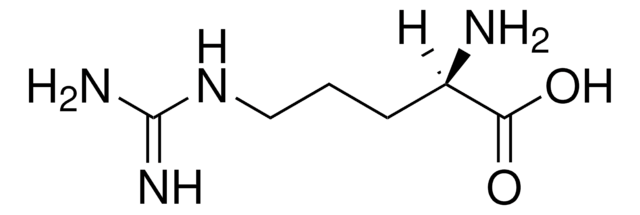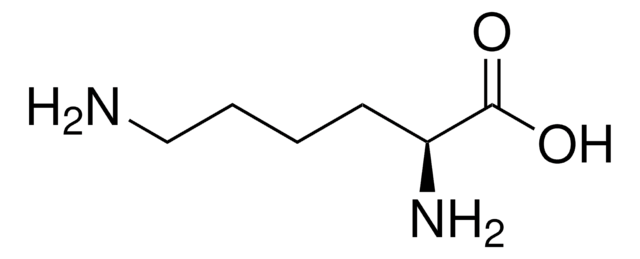모든 사진(5)
About This Item
실험식(Hill 표기법):
C6H14N4O2 · HCl
CAS Number:
Molecular Weight:
210.66
EC Number:
MDL number:
UNSPSC 코드:
12352209
PubChem Substance ID:
NACRES:
NA.26
추천 제품
제품명
DL-Arginine hydrochloride, ≥98% (TLC)
Quality Level
분석
≥98% (TLC)
양식
powder
색상
white to off-white
mp
128-130 °C
solubility
H2O: soluble
SMILES string
Cl.NC(CCCNC(N)=N)C(O)=O
InChI
1S/C6H14N4O2.ClH/c7-4(5(11)12)2-1-3-10-6(8)9;/h4H,1-3,7H2,(H,11,12)(H4,8,9,10);1H
InChI key
KWTQSFXGGICVPE-UHFFFAOYSA-N
애플리케이션
DL-Arginine hydrochloride (DL-Arg) is a racemic mixture of the natural proteinogenic amino acid L-arginine and the non-proteinogenic D-arginine. DL-Arg is used in physicochemical analysis of amino acid complexation dynamics and crystal structure formations.
기질
Substrate for nitric oxide synthetase; induces insulin release by a nitric oxide-dependent mechanism.
Storage Class Code
11 - Combustible Solids
WGK
WGK 3
Flash Point (°F)
Not applicable
Flash Point (°C)
Not applicable
개인 보호 장비
Eyeshields, Gloves, type N95 (US)
이미 열람한 고객
N T Saraswathi et al.
Acta crystallographica. Section B, Structural science, 59(Pt 5), 641-646 (2003-10-31)
The complexes of L-arginine and DL-lysine with pimelic acid are made up of singly positively charged zwitterionic amino acid cations and doubly negatively charged pimelate ions in a 2:1 ratio. In both structures, the amino acid molecules form twofold symmetric
Siddhartha Roy et al.
Acta crystallographica. Section B, Structural science, 61(Pt 1), 89-95 (2005-01-22)
The adipic acid complexes of DL-arginine and L-arginine are made up of zwitterionic, singularly positively charged arginium ions and doubly negatively charged adipate ions, with a 2:1 stoichiometry. One of the two crystallographically independent arginium ions in the L-arginine complex
Moyu Taniguchi et al.
Journal of bioscience and bioengineering, 124(4), 414-418 (2017-06-02)
Although naturally abundant amino acids are represented mainly by l-enantiomers, fermented foods are known to contain various d-amino acids. Enantiospecific profiles of food products can vary due to fermentation by bacteria, and such alterations may contribute to changes in food
Yosuke Nakano et al.
Journal of bioscience and bioengineering, 123(1), 134-138 (2016-08-21)
d-Amino acids have recently attracted much attention in various research fields including medical, clinical and food industry due to their important biological functions that differ from l-amino acid. Most chiral amino acid separation techniques require complicated derivatization procedures in order
Moyu Taniguchi et al.
Journal of bioscience and bioengineering, 130(1), 63-70 (2020-04-09)
Japanese sake production involves three processes: rice koji fermentation, seed mash fermentation, and main mash fermentation. Traditional seed mash (kimoto) production utilizes natural lactic acid produced by lactic acid bacteria for pure cultures of only sake yeast, preventing the growth
Chromatograms
application for HPLC자사의 과학자팀은 생명 과학, 재료 과학, 화학 합성, 크로마토그래피, 분석 및 기타 많은 영역을 포함한 모든 과학 분야에 경험이 있습니다..
고객지원팀으로 연락바랍니다.





